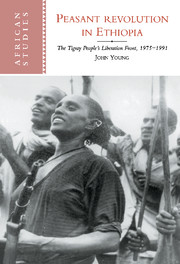Book contents
- Frontmatter
- Contents
- List of maps
- A note on names, transliteration and the Ethiopian Calendar
- Acknowledgements
- 1 Ethiopia
- Introduction
- 1 Peasants and revolutions: theoretical directions
- 2 Historical and social background
- 3 Tigray on the eve of insurrection
- 4 Struggle for opposition ascendancy: 1975–1978
- 5 Challenges and advances: 1978–1985
- 6 Triumph 1985–1991
- 7 TPLF and the peasants
- 8 Conclusion
- Notes
- Bibliography
- Index
- Titles in the series
7 - TPLF and the peasants
Published online by Cambridge University Press: 12 November 2009
- Frontmatter
- Contents
- List of maps
- A note on names, transliteration and the Ethiopian Calendar
- Acknowledgements
- 1 Ethiopia
- Introduction
- 1 Peasants and revolutions: theoretical directions
- 2 Historical and social background
- 3 Tigray on the eve of insurrection
- 4 Struggle for opposition ascendancy: 1975–1978
- 5 Challenges and advances: 1978–1985
- 6 Triumph 1985–1991
- 7 TPLF and the peasants
- 8 Conclusion
- Notes
- Bibliography
- Index
- Titles in the series
Summary
Introduction
The desire to transform both Tigray, and its relationship with the state, was the fundamental reason why the TPLF launched its revolution, but realising this objective could only come about through successfully waging revolutionary war. What this meant in practice was that no matter how worthy this transformative project was, it could not be considered independently from the impact it had on the war effort. What was necessary then was a programme of reforms which balanced the needs of peasants for land redistribution, effective services, and accountable administration, with the needs of the TPLF for growing committed support for armed struggle. In an environment where the Derg and most revolutionary movements treated peasants with contempt, the TPLF leadership understood that success depended on its ability to maintain the unwavering commitment of the peasants. The objective here is to consider the TPLF–peasant relationship in five areas critical to winning peasant support and directing it to the war effort: education and culture, the Church and religion, women, land reform, and local administration.
Education and culture
Much of the TPLF nationalist appeal made the point that peasant poverty and lack of infrastructure in the villages were the result of state domination by an Amhara elite which wanted to keep Tigray in subjugation. Peasants responded by asking the TPLF as ‘sons of Tigray’ to supply their communities with the facilities they needed, and high on the list were schools.
- Type
- Chapter
- Information
- Peasant Revolution in EthiopiaThe Tigray People's Liberation Front, 1975–1991, pp. 172 - 196Publisher: Cambridge University PressPrint publication year: 1997

